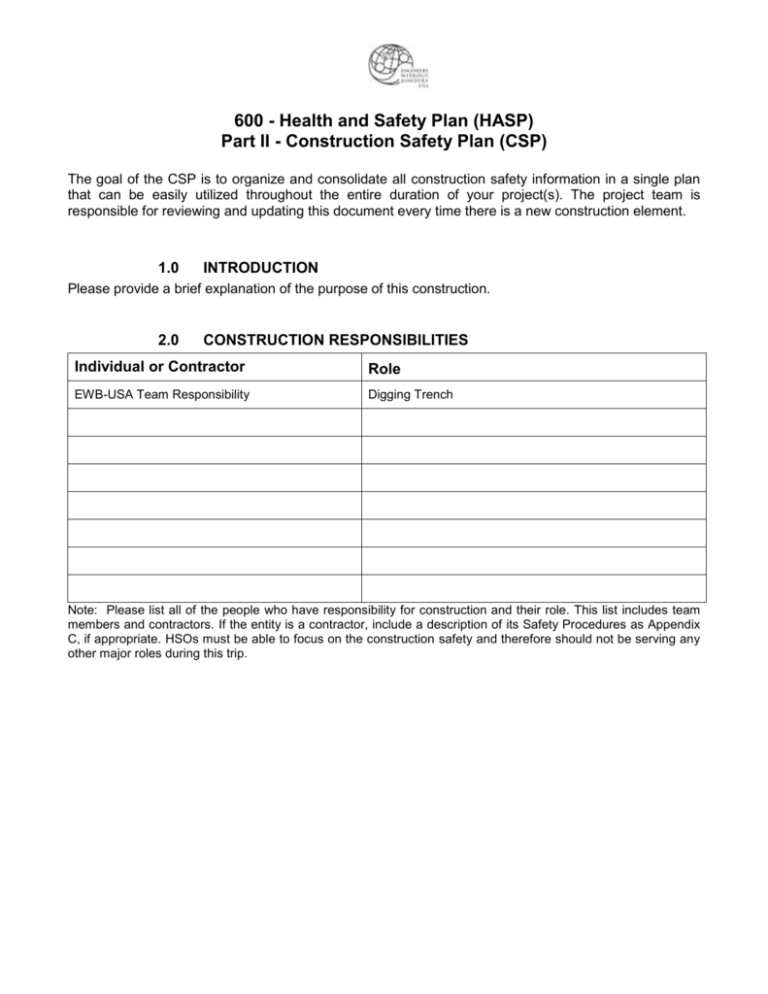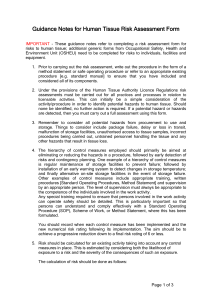
600 - Health and Safety Plan (HASP)
Part II - Construction Safety Plan (CSP)
The goal of the CSP is to organize and consolidate all construction safety information in a single plan
that can be easily utilized throughout the entire duration of your project(s). The project team is
responsible for reviewing and updating this document every time there is a new construction element.
1.0
INTRODUCTION
Please provide a brief explanation of the purpose of this construction.
2.0
CONSTRUCTION RESPONSIBILITIES
Individual or Contractor
Role
EWB-USA Team Responsibility
Digging Trench
Note: Please list all of the people who have responsibility for construction and their role. This list includes team
members and contractors. If the entity is a contractor, include a description of its Safety Procedures as Appendix
C, if appropriate. HSOs must be able to focus on the construction safety and therefore should not be serving any
other major roles during this trip.
600 – Health and Safety Plan – Part I – Travel Safety Plan
Name of Chapter
Country, Community, Project Id(s)
3.0
Revised 12/2015
CONSTRUCTION SCHEDULE
Please insert the construction schedule by task (delete example below):
Number Task
Start
End
Duration
1
General Health &
Safety Considerations EWB
6/1/10
10/1/10
4 months
2
Install new electrical Public Utility
pole and transformer Co.
6/3/10
7/30/10
2 months
3
Construct new sump
well
EWB
8/1/10
8/15/10
15 days
4
Construct pump
security structure
EWB
8/15/10
9/1/01
15 days
EWB
8/15/10
9/1/10
15 days
EWB/Public
Utility Co.
9/1/10
9/15/10
15 days
EWB/Public
Utility Co.
9/15/10
10/1/10
15 days
5
6
Resource
Install
Install piping
pump and
make electrical and
pipe connections
7
Test System
Example Schedule
4.0
June
July
2010
August
Sept.
CONSTRUCTION TASK SAFETY RISK ANALYSIS
Using the tasks stated in Section 3.0, complete the following tables in the order of the tasks in Section
3.0 from the team’s perspective, rather than referral to a technique listed from another source. These
descriptions should fully describe the task, discuss the construction techniques, as they have been
adapted to local conditions, and identify the hazards, steps to mitigate those hazards, as well as identify
the tools and personal protective equipment needed for each task.
All construction techniques must demonstrate an understanding of local conditions and references to
resources (such as construction manuals) will not be accepted.
Task #1 shall always include a general description of health and safety considerations that will be used
for the entire duration of the trip. The team will focus on accident prevention throughout the trip to
prevent injuries.
Task #1 – General Health and Safety Considerations
Hazard(s)
Step(s) to Mitigate Hazard
Chemical
Biological
Physical
Tools Needed
Personal Protective Equipment
(PPE) Needed
© 2015 Engineers Without Borders USA. All Rights Reserved
Page 2 of 9
600 – Health and Safety Plan – Part I – Travel Safety Plan
Name of Chapter
Country, Community, Project Id(s)
Revised 12/2015
Task #2 – Task description
Hazard(s)
Step(s) to Mitigate Hazard
Chemical
Biological
Physical
Tools Needed
Personal Protective Equipment
(PPE) Needed
© 2015 Engineers Without Borders USA. All Rights Reserved
Page 3 of 9
600 – Health and Safety Plan – Part I – Travel Safety Plan
Name of Chapter
Country, Community, Project Id(s)
5.0
Revised 12/2015
CONSTRUCTION TASK HAZARDS SUMMARY
Based on the identification of hazards in the previous section, the HSO should take the following
actions.
1. Select the applicable task hazards from EWB-USA’s Task Hazards documents
2. Summarize their inclusion in Table 4.1 and insert them in Appendix D.
3. Review them for necessary modifications. If modifications are made to the Task Hazard, those
modifications shall be made in BOLD and ITALIC on the task hazard sheet and noted here. All
modified Task Hazards should be submitted for approval.
Task Hazard #
Reason for Modification
Note: The task hazards listed in this section are the same hazards that are described in the tables in
Sections 3.0 and 4.0.
© 2015 Engineers Without Borders USA. All Rights Reserved
Page 4 of 9
600 – Health and Safety Plan – Part I – Travel Safety Plan
Name of Chapter
Country, Community, Project Id(s)
Revised 12/2015
Table 5.1
Checklist of Tasks and Associated Hazards
Task # (from Section 4.0)
#1
#2
#3
#4
#5
#6
#7
Anticipated Task Hazards
Type
Chemical*
Biological
Physical
TH 01
Noise and Hearing
TH 02
Inclement Weather
TH 03
Heat Stress
TH 04
Cold Stress
TH 05
Foot Care
TH 06
Confined Spaces
TH 07
Hot Work
TH 08
Manual Lifting
TH 09
Rough Terrain
TH 10
Housekeeping
TH 11
Structural Hazards
TH 12
Remote Areas
TH 13
Working Over/Near Water
TH 14
Traffic and Vehicles
TH 15
Heavy Equipment
TH 16
Fall Protection
TH 17
Ladders
TH 18
Shoring and Trenching
TH 19
Hazardous Material Storage
TH 20
Demolition
TH 21
Utilities and Landmines
TH 22
Electrical Safety
TH 23
Hand and Power Tools
TH 24
Hand and Emergency Signals
TH 25
Lock Out Tag Out
TH 26
Biological Hazards
TH 27
Hazardous Materials
TH 28
Clear, Grubbing, and Logging
TH 29
Falling Objects
TH 30
Silica
* Provide the Material Safety Data Sheets (MSDS) for any chemical hazards for example cements, nonstandard cleaners, calcium hydrochlorite (chlorine tablets), oils/grease, etc. in Appendix E.
© 2015 Engineers Without Borders USA. All Rights Reserved
Page 5 of 9
600 – Health and Safety Plan – Part I – Travel Safety Plan
Name of Chapter
Country, Community, Project Id(s)
6.0
Revised 12/2015
SAFETY MEETINGS
The Health and Safety Officers will hold daily safety meetings at the project site prior to the
commencement of daily activities. Community members involved with the constructions tasks must be
included in the daily safety meetings. All relevant hazards potentially encountered over the course of
the day will be identified and management strategies will be discussed.
Notes of daily safety meetings should be kept by the HSO and should include the following information:
o
o
o
Names of those who are present, including community members
Items of work discussed
Conclusions
These notes should be kept in the project documentation of the chapter.
© 2015 Engineers Without Borders USA. All Rights Reserved
Page 6 of 9
600 – Health and Safety Plan – Part I – Travel Safety Plan
Name of Chapter
Country, Community, Project Id(s)
Revised 12/2015
APPENDIX C: Contractor Safety Procedures
If a contractor is involved, include a description of its Safety Procedures, if appropriate.
© 2015 Engineers Without Borders USA. All Rights Reserved
Page 7 of 9
600 – Health and Safety Plan – Part I – Travel Safety Plan
Name of Chapter
Country, Community, Project Id(s)
Revised 12/2015
APPENDIX D: Task Hazards
Include all Task Hazards Identified as Necessary in Table 5.1
The Task Hazard pages do not have to be submitted for review unless changes are made to
the protocols. If the team would like to modify the task hazards, the proposed modifications
must be brought to EWB-USA’s attention, using bold and italic on the Task Hazard.
© 2015 Engineers Without Borders USA. All Rights Reserved
Page 8 of 9
600 – Health and Safety Plan – Part I – Travel Safety Plan
Name of Chapter
Country, Community, Project Id(s)
Revised 12/2015
APPENDIX E: Material Safety Data Sheets (MSDS)
Provide the Material Safety Data Sheets (MSDS) for any chemical hazards for example cements, nonstandard cleaners, calcium hydrochlorite (chlorine tablets), oils/grease, etc.
© 2015 Engineers Without Borders USA. All Rights Reserved
Page 9 of 9









